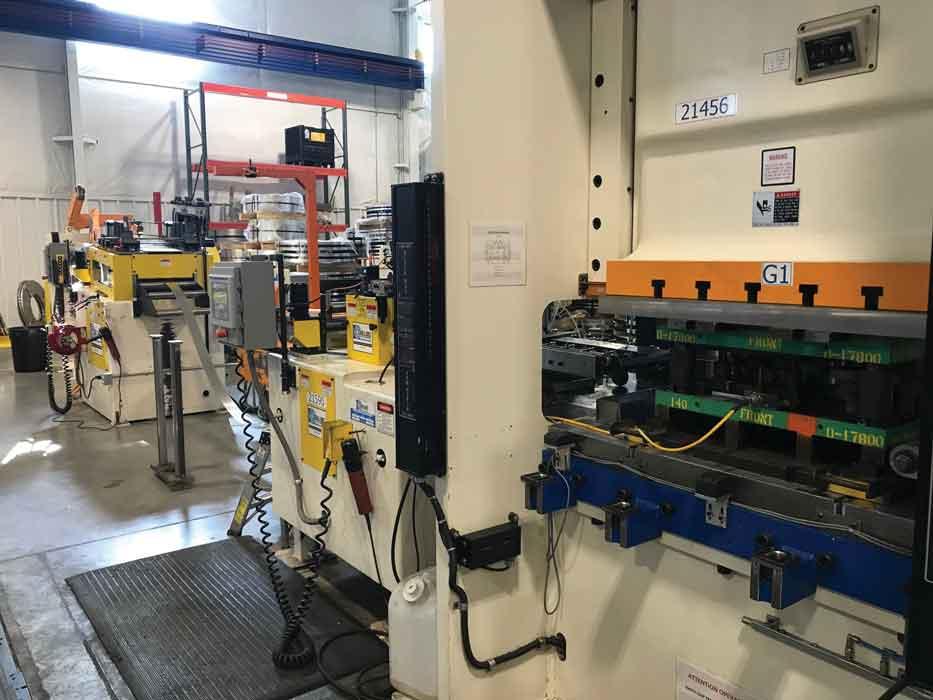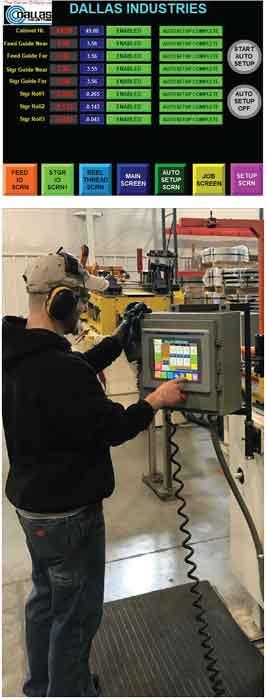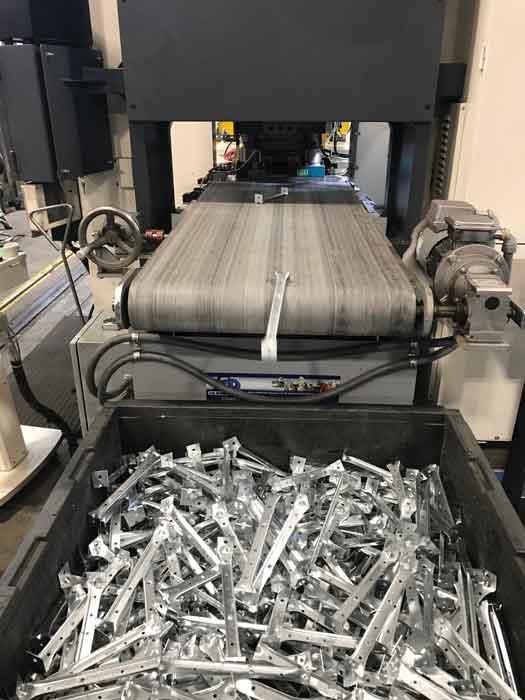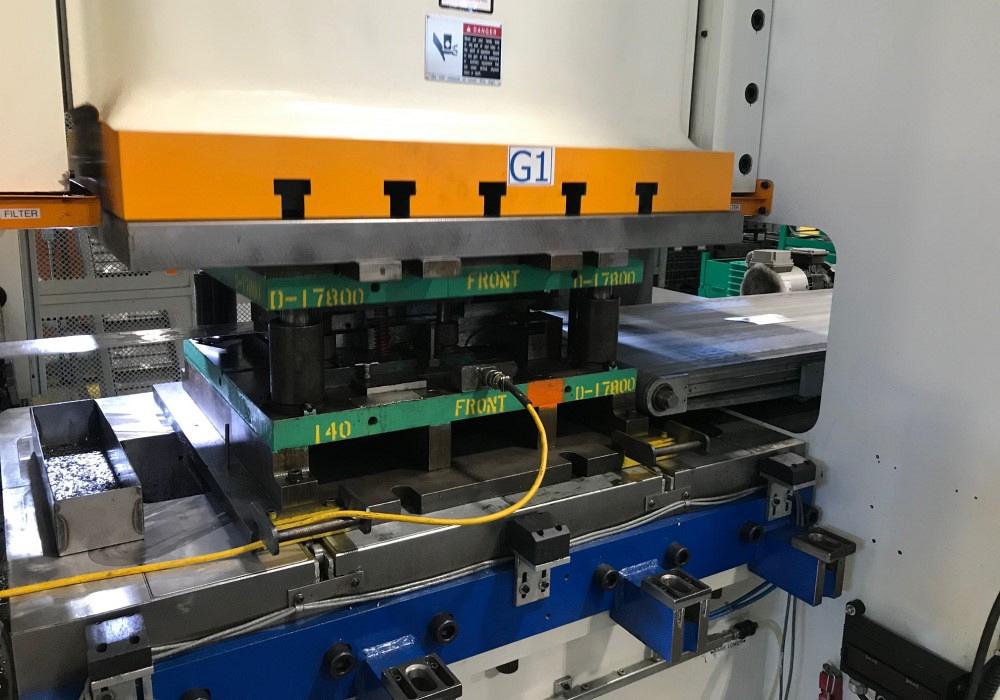Contributing editor
- FMA
- The Fabricator
- FABTECH
- Canadian Metalworking
Categories
- Additive Manufacturing
- Aluminum Welding
- Arc Welding
- Assembly and Joining
- Automation and Robotics
- Bending and Forming
- Consumables
- Cutting and Weld Prep
- Electric Vehicles
- En Español
- Finishing
- Hydroforming
- Laser Cutting
- Laser Welding
- Machining
- Manufacturing Software
- Materials Handling
- Metals/Materials
- Oxyfuel Cutting
- Plasma Cutting
- Power Tools
- Punching and Other Holemaking
- Roll Forming
- Safety
- Sawing
- Shearing
- Shop Management
- Testing and Measuring
- Tube and Pipe Fabrication
- Tube and Pipe Production
- Waterjet Cutting
Industry Directory
Webcasts
Podcasts
FAB 40
Advertise
Subscribe
Account Login
Search
Air movement equipment manufacturer advances with servo press system, Part II
Automated press feed, material handling equipment simplifies and shortens setup
- By Kate Bachman
- July 30, 2020
- Article
- Bending and Forming

Fan manufacturer Greenheck installed an advanced press feed system and automated material handling equipment to help it to meet increased demand and the need for faster production. With autosetup, all critical functions are done at the control. Photos courtesy of Greenheck Fan Co.
Editor’s Note: This article is Part II of a two-part article. To learn more about the press, read Part I.
Greenheck Fan Co., Schofield, Wis., is one of the largest industrial and commercial HVAC suppliers in the world. Its global footprint includes manufacturing plants throughout the U.S., a location in Mexico, and another in India.
The company manufactures hundreds of SKUs, with air movement equipment ranging from fans, louvers, and dampers to ventilators, circulators, and energy recovery systems. There is a lot of variety within each product type, too. Fans range in size from 12 by 12 by 4 in. to 12 ft. tall by 10 ft. by 6 ft.
The large number of products equates to a large number of press changes, according to Manufacturing Engineer Tom Franke.
The nature of fanmaking means frequent material changes as well. “Our blades are made of anything from just a 5052 aluminum to a 3000 aluminum to hot-rolled steel, cold-rolled steel, and even galvanized steel. And then we run a few that are stainless as well.”
Greenheck Fan Co. has placed a major focus on lean manufacturing, Franke said. “So, we’re trying to be as lean as possible,” he said.
To help meet the challenges of frequent job changeovers on the press while striving for a lean operation, Greenheck installed something new for the pressroom—a servo press with a fully automated feed line.
The goal was to have a system that could produce small batches of parts to minimize inventory while reducing changeover from one part run to the next to support the company’s lean manufacturing goals.
“We wanted a machine system that would allow an operator to walk up to it, hit a button, and everything would move to where it needed to go,” Franke said.
Greenheck relied on supplier BDC Machinery to specify, integrate, and coordinate installation of a SEYI SD1-220 servo press system with fully automated material handling.

Greenheck Fan. Co. installed a Dallas Industries automated feed line for its new servo press to improve changeover time from job to job.
“After a thorough review of production requirements with the focus on lean manufacturing, we determined that the press alone would not help the company achieve its lean goals, and that an automated feed line was required, BDC Machinery President Rick Wenzel said.
Automated Coil, Press Feed
A Dallas Industries automated feed line was installed for the new press.
When a job number is selected at the press control, it is then transmitted to the feed line control. That is fairly standard; however, then all critical adjustments required for each type of material or job selected, such as brake tension, straightener roll adjustment, vertical guides, feed length, roll pressure, and passline height, are all completed from the control within 90 seconds or less, according to Wenzel.
Franke said that everything from the roll guides to the leveling table to the tailout mode is automated. Basically, every setting is controlled off the controller rather than being manually controlled. “The only manual movement we have on the line is our pilot height. The operator loads the coil, strings it through, and it runs,“ Franke said.
“So on a typical machine, you have to manually go change the roll feed guides, manually change the straightener roll, where now we run in auto mode.
“So as that final strip is coming through the feed system, we’ll put it into tailout mode.” Franke said that allows the operator already to be loading coil for the next job. As soon as that material is through the straightener and feeder and into the press, it’s automatically setting up for the next job.
“At that point we’re already moving our cabinet height to where it needs to be for the next die. Our feed speeds, our roll pressures, those are already being adjusted. So rather than manually having to do everything on the feed line, it’s all automated to a point where the operator just needs to pull the strip out, demagnetize the die, bring the cart over, and swap it out. It’s incredibly fast compared to a standard system.”
Franke said that on a similarly sized mechanical press with manual setup, it takes half hour to 40 minutes to set up.
The rapid changeover time is critical, he said. It is no longer typical to have long runs that last a day or two. The pressroom is changing over the press for different products about 10 to 15 times a day during a three-shift operation. Franke added, “We’re running for two or three hours on one job and then we’re swapping over to a new die.”
Dallas Industries CEO Willie Chacko described the automated material handling options (see Figure 1).

Figure 1
When a job number is selected at the press control, it is then transmitted to the feed line control. Critical adjustments required for each type of material or job selected, such as brake tension, straightener roll adjustment, vertical guides, feed length, roll pressure, and passline height, can be executed from the control. Screenshot courtesy of Dallas Industries.
“The feed guides, near and far, are in place at various locations to guide the material through straight into the press. The control auto adjusts for the size of the coil, the thickness of the material, and the end of the material,” Chacko said.
Auto Setup
Chacko cited three efficiencies that the auto setup is designed to deliver.
- Fast Changeover. Chacko said the auto setup results in a very fast changeover. ”So when they’re ready for a job changeover, the operator selects the job, hits ‘start auto setup,’ and the coil feed changes from the previous position to the new position of the next job in about one minute.”
- Repeatability. Chacko said that the second important aspect of auto setup is repeatability. “Once the machine setup is exactly what had previously been stored, it doesn’t matter who loads it; it will always be set up the same.” The system has password-protected parameters so that when an operator loads the job, the machine sets up to those parameters every time. “The repeatable aspect is very important,” he said.
- Simplified Material Loading. The third aspect is ease of loading the material. “When they set up a job, the machine sets up automatically to guide the coil all the way. The strip moves relatively easily through the straightener onto the prep table and into the die.
“Loading the strip from the coil to the press is much easier because the machine is already positioned where it should be.”
Communication
In addition to the automatic setup, the coil feed must communicate in sync with the press.
SEYI’s standard control was adaptable for the communication needed with auxiliary equipment to complete the cell. The press OEM provided communication protocols that facilitated the ability to access and update the machine control remotely once it was in place on Greenheck’s plant floor. The control was also able to perform all process monitoring required without the need to add additional aftermarket process controls, according to Wenzel.
“What that does is when the operator does a job changeover, he or she gets information as to which job is running next over Ethernet,” Wenzel said. The operator does not have to be at the controller to select the job. The controller finds the job in the feed system and loads it up automatically. “That prevents an error if somebody loads job A on one side and loads job B on the other side.”
Quick Die Change, Magnetic Die Clamping
All of the company’s presses have quick die changeover, but the new press’s die locating and die holding system is magnetic. The magnetic die clamping system and Greenheck’s two-station die cart facilitated a quick die change system that can be completed in minutes.

The large number of products Greenheck stamps and materials it uses on short runs equate to a large number of press changes.
“This not only saves time, it also reduces the need for highly skilled and high-cost labor. Once combined with quick die change and appropriate part-out conveyance, the system is able to perform hit-to-hit times in as little as a quarter of an hour,” Wenzel said.
“The magnetic clamping was one of the unique features we added,” Franke said. “We customized the bolster so that the magnets fit around the scrap slots. We can drop all our scrap through the bottom onto a conveyor underneath rather than transferring it onto a shaker conveyor out the back. That was a big bonus that we hadn’t had in the past. That was really unique to this machine.”
Because the opening was large, limited space was available for the magnets. To overcome this challenge, the system provider, EAS, installed its LP Press- mag system with high holding forces.
The quick die change system includes rolling bolsters and a die cart that allow operators to preload a die.
“Now, with our automated press feed and magnetic die change system, an operator can effectively change out the die and coil line on the press and go from last good part to first good part in 15 to 18 minutes,” Franke added.
About the Author

Kate Bachman
815-381-1302
Kate Bachman is a contributing editor for The FABRICATOR editor. Bachman has more than 20 years of experience as a writer and editor in the manufacturing and other industries.
Related Companies
subscribe now

The Fabricator is North America's leading magazine for the metal forming and fabricating industry. The magazine delivers the news, technical articles, and case histories that enable fabricators to do their jobs more efficiently. The Fabricator has served the industry since 1970.
start your free subscription- Stay connected from anywhere

Easily access valuable industry resources now with full access to the digital edition of The Fabricator.

Easily access valuable industry resources now with full access to the digital edition of The Welder.

Easily access valuable industry resources now with full access to the digital edition of The Tube and Pipe Journal.
- Podcasting
- Podcast:
- The Fabricator Podcast
- Published:
- 04/16/2024
- Running Time:
- 63:29
In this episode of The Fabricator Podcast, Caleb Chamberlain, co-founder and CEO of OSH Cut, discusses his company’s...
- Industry Events
16th Annual Safety Conference
- April 30 - May 1, 2024
- Elgin,
Pipe and Tube Conference
- May 21 - 22, 2024
- Omaha, NE
World-Class Roll Forming Workshop
- June 5 - 6, 2024
- Louisville, KY
Advanced Laser Application Workshop
- June 25 - 27, 2024
- Novi, MI
































